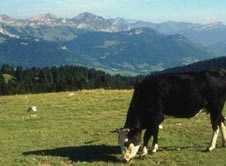|
If you think about farmers raising cattle, you probably conjure up something like this happy cow scene: Mellow heifers quietly grazing on the lush grass of the rolling countryside, lazily swishing their tails at pesky bugs. New-born and young calves getting nourishment from the milk in their mothers' teats. For us here at Grinning Planet, such images make us reminisce about our days in the Mu Alpha Mu fraternity, when we'd hang out at the Dairy Queen every Friday after class singing all the great milk-drinking songs.
But back to the dreamy visions of cow country. It seems there is a nightmarish underbelly here, and much of the nightmare centers on animal feed.
While it's true that cows typically spend the first year or two of their lives grazing on pasture, there are two ugly facts about how "agribusiness" in the US feeds cows:
- A baby cow does not typically feed from its mother's teat, but rather is fed a bottled formula mix that contains (among other things) the blood of cows that have previously been slaughtered. Eww!
- Once a maturing cow leaves the pasture for the feed lots, it is typically given a feed mix that contains slaughterhouse waste—parts from cows, pigs, and chickens that have been ground up, rendered, and mixed with grain or other feed stocks. Double eww!
Basically, those in the ranching and feedlot industries have turned cows—which are purely vegetarian by design—into meat-eaters,
 and to some extent, unwitting cannibals. Most people have a visceral negative reaction to the concept of cannibalism, even when it occurs naturally in a species. But in this case, the cows' cannibalism is 100% at man's insistence. Profit and pricing pressures are behind it—slaughterhouse waste is a cheap source of food for the grower's operations.
and to some extent, unwitting cannibals. Most people have a visceral negative reaction to the concept of cannibalism, even when it occurs naturally in a species. But in this case, the cows' cannibalism is 100% at man's insistence. Profit and pricing pressures are behind it—slaughterhouse waste is a cheap source of food for the grower's operations.
Maybe you think serving up cow's blood to calves and rendered slaughterhouse waste to feedlot cattle are shady, fringe practices. But such feedings are standard in the beef industry, and completely within current regulations. The beef industry has aggressively tried to quell any discussion of the issue, and they generally get full support from the US Department of Agriculture and the Food and Drug Administration.
Though "recycling" of animal slaughter waste may seem somewhat appealing from a waste-disposal perspective, the barbarity of these practices is enough to make one cringe. But there is an even worse
|
|
problem with these methods. In the next Eco-Logical, we'll talk about how Mad Cow Disease relates to these feeding practices, and we'll offer some suggestions for finding beef that is free of freakish feeds. Now, if you'll excuse us, we're late for our daily three-milkshake business lunch. Mooooo.
Go to Part 2
Learn Which Labels Help You Avoid Beef with Slaughterhouse Waste (and Mad Cow Disease)
|
| |
|
BRAIN FOOD |
|
Upton Sinclair's 1905 book "The Jungle" exposed the horrific practices of the early-1900s meat-packing industry. After a White House luncheon with Sinclair, President Theodore Roosevelt sent investigators to Chicago to check out the reports of rampant grossness. In 1906, the "Pure Food and Drug Act" and the "Meat Inspection Act" were signed into US law to clean up the industry.
|
|


